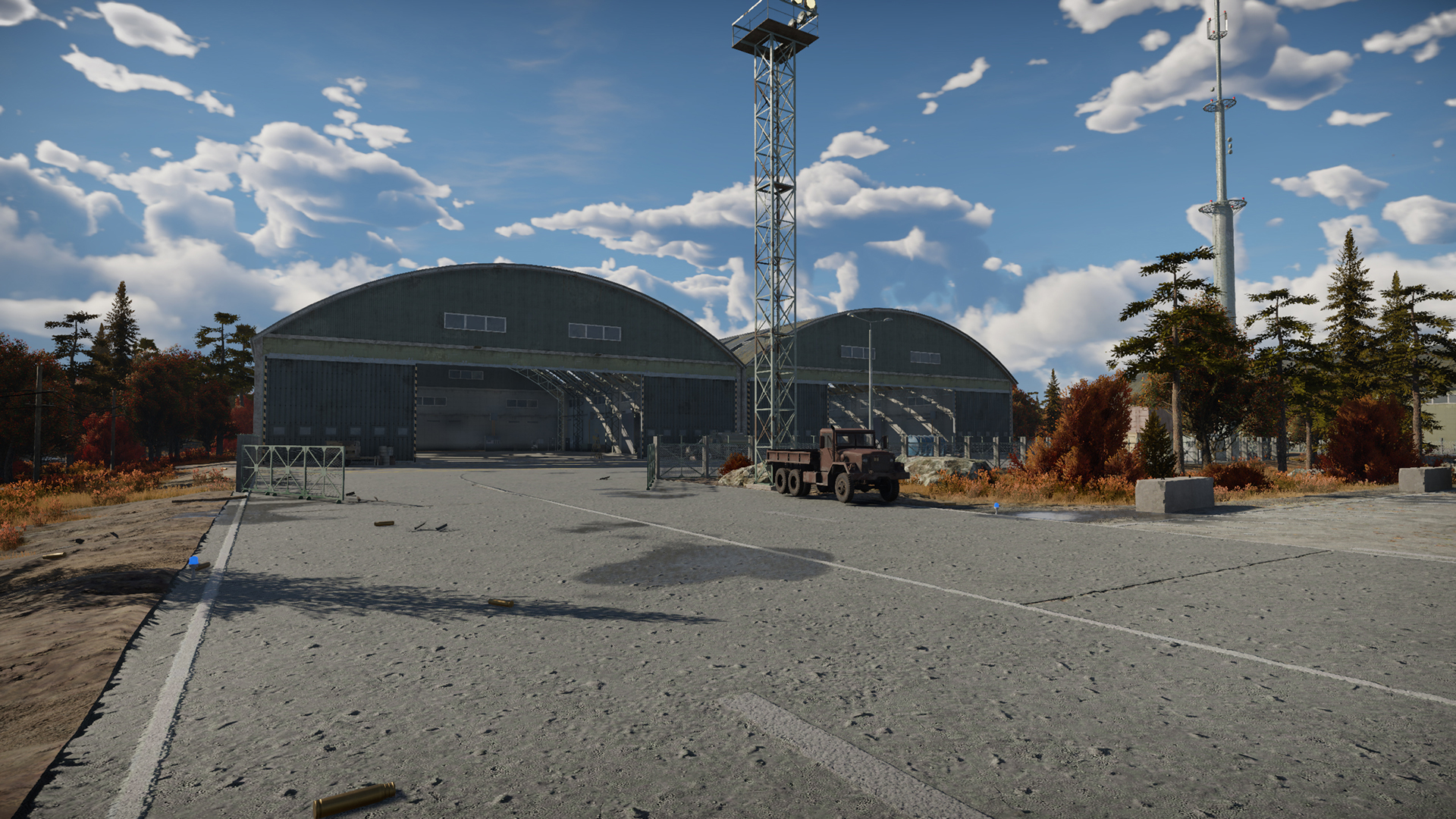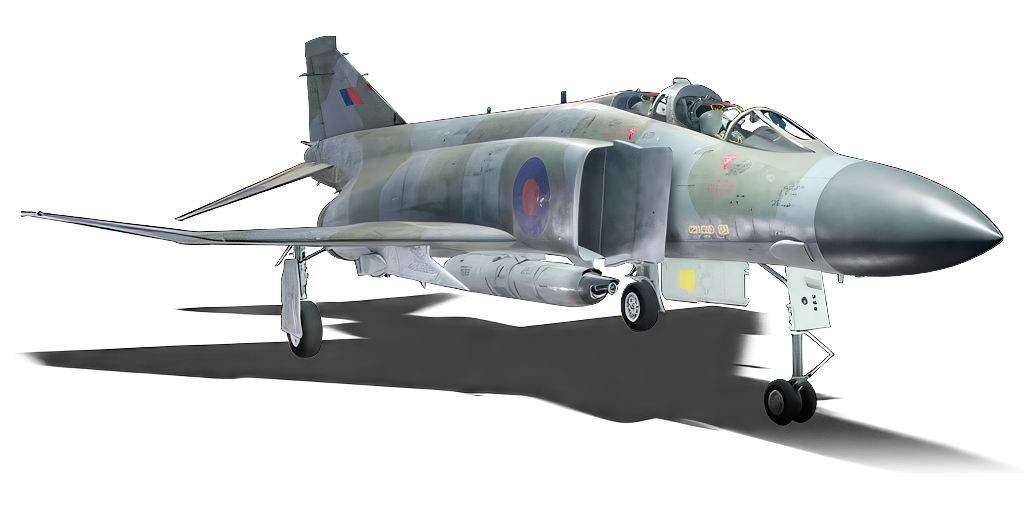受BWiki近期改动影响,普通用户无法访问除重定向、编辑表格外的特殊页面(如最近更改等),进行3次有效编辑后即可正常访问。
鬼怪 FGR.2
阅读
2024-02-19更新
最新编辑:瓦瑞克Warrick
阅读:
更新日期:2024-02-19
最新编辑:瓦瑞克Warrick
本条目介绍的是英国的战斗机鬼怪 FGR.2。 关于其他版本,请参阅F-4 (消歧义)。
介绍
鬼怪 FGR.2,也被称为F-4M,是一架VII级英国喷气式战斗机,权重分别为11.0(街机/全真)和11.3(历史)。它是在重大版本更新1.93"Shark Attack"中引入的。它是著名的美国F-4 鬼怪II的英国版本。
虽然乍一看,FGR.2与美国的F-4C非常相似,但这两架飞机之间存在许多外观性能上的差异。为英国皇家空军生产的鬼怪被重新设计以使用英国罗尔斯·罗伊斯"斯贝"涡轮风扇发动机,而不是美国鬼怪上使用的通用电气J79涡轮喷气发动机。相较于美制发动机,其能产生更大的推力,但"斯贝"的体积明显更大;因此,英国鬼怪的机身被修改得比美国型号略宽。此外,鬼怪FGR.2拥有比F-4C更大的进气口,以便适应新发动机所需的更多气流。鬼怪FGR.2的机身后部相比其他鬼怪战机也有很大不同;发动机明显向下倾斜,并且由于"斯贝"发动机上的加力燃烧室布置不同,排气口和周围区域进行了重新设计。最独特的是,鬼怪FGR.2具有方形尾部,并且缺少F-4C的机头下探头。
在游戏中,这些变化意味着与F-4C相比,"斯贝"发动机所带来的澎湃动力使得鬼怪FGR.2具有更好的低空加速度和爬升率。在游戏中,您经常会看到与F4C相比,鬼怪FGR.2能更快的离开地面和到达指定高度。然而,由于重新设计的机身阻力增加,以及"斯贝"发动机的性能特征,它在高空的表现(可能)不如F-4C,并且无法达到与其相同的最大速度。
基本信息
飞行性能
最大速度
在10667米 2268千米/时
实用升限 16 000 m
引擎 2x 罗尔斯·罗伊斯"斯贝"203
冷却方式 气冷
起飞重量 25 t
鬼怪FGR.2是一架大型、重型飞机(其重量是米格21的两倍多),但有时你几乎感受不到这一点。这架鬼怪的两架罗尔斯·罗伊斯"斯贝"涡轮风扇发动机是游戏中最强大的喷气发动机之一,赋予了其令人难以置信的推重比,使得鬼怪FGR.2拥有游戏中最好的加速能力,并且在低空中成为游戏内最快的飞机,同时在顶级房的飞机爬升比赛也是一把好手。在起飞时,即使是白板的FGR.2也将是第一架离开地面并飞越跑道末端的飞机(这相当优秀);而就平飞速度而言,完全体的FGR.2可以达到难以置信的1.22马赫,比任何其他飞机都要快得多。英国鬼怪的爬升也非常好,当她装载20分钟的燃料,导弹和机炮吊舱时,她可以在20°爬升中加速并使自己的速度超过1马赫,甚至可以在50°爬升中继续加速(直到达到约2000米的高度);只有少数飞机能够有与FGR.2一样或者更好的爬升能力。
虽然鬼怪FGR.2肯定不是游戏中机动性最强的战斗机,但它在低空时的敏捷可能会超出你的预期。 虽然你不应该轻易进入到绕圈狗斗的境况之下,但鬼怪在低速时的机动表现得非常好,并可以拉出一些机动,同时相比其他鬼怪这架飞机的速度损失也不会很大(主要是由于其发动机的可怕功率)。
但鬼怪FGR.2的如上优点却带来了一些其他缺点,其遭受损失的地方是在更高的高空,"斯贝"发动机在特定高度之上的性能更差,并且由于鬼怪FGR.2的机体需要适应新的发动机,工程师们改动了这架鬼怪的结构,这导致了空气阻力增加,使得她比美国的F-4C慢。在高空,FGR.2失去了它在低空的优秀的机动性,并且会比其他鬼怪表现得更为糟糕。虽然她仍然拥有一定的机动性,但其的规避机动能力惨不忍睹,而且转弯半径也会比其他鬼怪更大。
| 飞行性能特征 | 最大速度 (千米/时,于10,667米) |
实用升限 (米) |
Turn time (秒) |
Rate of climb (米/秒) |
Take-off run (米) | |||
|---|---|---|---|---|---|---|---|---|
| AB | RB | AB | RB | AB | RB | |||
| 初始 | 2189 | 2146 | 16000 | 26.5 | 26.7 | 176.0 | 165.3 | 850 |
| 完全体 | 2355 | 2268 | 25.5 | 26.0 | 246.9 | 210.0 | ||
细节
| 部件 | |||||
|---|---|---|---|---|---|
| 作战襟翼 | 起飞襟翼 | 着陆襟翼 | 减速板 | 制动装置 | 减速伞 |
| X | ✓ | ✓ | ✓ | ✓ | ✓ |
| 极限 | ||||||
|---|---|---|---|---|---|---|
| 机翼(km/h) | 起落架(km/h) | 襟翼(km/h) | 最大过载 | |||
| 作战 | 起飞 | 着陆 | + | - | ||
| 1458 | 463 | N/A | 584 | 463 | ~11 | ~4 |
| 最佳速度(km/h) | |||
|---|---|---|---|
| 副翼 | 方向舵 | 升降舵 | 散热器 |
| < 810 | < 750 | < 700 | N/A |
| 引擎 | 飞机重量 | ||||||
|---|---|---|---|---|---|---|---|
| 引擎型号 | 数目 | 基础重量 | 机翼载荷(全燃料) | ||||
| 罗尔斯·罗伊斯 "斯贝" 203 | 2 | 13,645 kg | 396 kg/m2 | ||||
| 发动机数据 | 携带燃料总重量 (未携带武器) | 最大起飞 重量 | |||||
| 重量 (每个) | 发动机类型 | 10m 燃料 | 20m 燃料 | 30m 燃料 | 33m 燃料 | ||
| 1,860 kg | 小涵道比涡扇发动机(带加力燃烧室) | 15,397 kg | 17,124 kg | 18,863 kg | 19,485 kg | 25,400 kg | |
| 引擎最大推力 @ 0 m (街机/历史) | 推重比 @ 0 m (加力) | ||||||
| 节流阀状态 | 100% | 加力 | 10m 燃料 | 20m 燃料 | 30m 燃料 | 33m 燃料 | 最大起飞重量 |
| 静止 | 5,120 kgf | 9,031 kgf | 1.17 | 1.05 | 0.96 | 0.93 | 0.71 |
| 最优 | 5,120 kgf (0 km/h) |
10,331 kgf (1,200 km/h) |
1.34 | 1.21 | 1.10 | 1.06 | 0.81 |
生存性及装甲
成员数量 2
解体速度
机体 1458 千米/时
起落架 463 千米/时
与较旧的F-4C变体非常相似(编者:这一篇wiki一直在拿鬼C做对比,虽然当年可能没出鬼J你没法讲得太详细,但10.0和11.3 emmm),英国的鬼怪FGR.2没有任何装甲保护 - 重量减轻使飞机能够携带更多的燃料或弹药,同时利用速度作为其最佳防御手段。该机有多个油箱,有一些位于机翼的前缘,但大多数油箱都位于发动机周围和驾驶舱后面的机身内。鬼怪FGR.2的控制钢索从驾驶舱向下延伸到上机身的长度到尾翼,相对而言其更容易暴露在敌人的炮火之下。
试图击落鬼怪FGR.2的战斗机应该尝试用导弹迫使它在机动中失去能量 - 没有速度的鬼怪是不堪一击的。机炮和导弹对于瘫痪或摧毁关键部件是最有效的,但是在迎面交战(高贵的对头)时齐射的如M/55,SNEB Type 23或FFAR Mighty Mouse等较小的无制导火箭弹可能会形成弹幕,以至于鬼怪FGR.2可能无法全部避开至少撞上他们中的一个。
改装件和经济
最高维修费 白板 → 完全体
街机 2 882 → 3 895
历史 498 → 11 483
全真 8 759 → 11 836
改装件总成本 488 000
457 000
护身符 2 800
成员组培训费 260 000
专家 930 000
王牌 2 800
王牌(研发点) 1 080 000
战斗收益 街机 / 历史 / 全真
99% / 300% / 600%
232% / 232% / 232%
鬼怪 FGR.2的配件研发顺序一定程度上取决于人们想要怎么体验这架飞机。AIM-9D导弹是顶喷房的最佳导弹之一(大嘘),因此大多数导弹战斗爱好者(编者:空格猴子)可能希望尽快解锁它们。如果您不需要导弹,那么一个明智的做法可能是专注于解锁“20毫米弹链”和“新的20毫米机炮”改装,减少机炮的散步,使其更加实用;如果希望用这架飞机进行地面攻击,那么对地武器的研发是显而易见的选择(尽管FGR.2在这个角色中的表现不如美国同行)。当装备8 x 1000磅炸弹时,FGR.2将成为强大的轰炸机(编者:罗兰警告);利用其优异的低空性能,以令人难以置信的速度到达敌人的基地,您也可以通过解锁炸弹轰炸基地来加速研发,但FGR.2是一种优异的的空战战斗机,所以这一方法不是必需的。
即使带满挂载,鬼怪 FGR.2也是游戏中低空性能最好的飞机;考虑到这一点,飞行性能的升级改装并不像其他飞机那样重要,因此武器升级可以优先考虑。在研发飞行性能升级时,人们应该专注于发动机升级,以进一步提升FGR.2令人难以置信的加速和爬升性能。
可能的挂载改装优先级 (取决于您的游戏风格)
- 强大的导弹: AIM-9D, AIM-9G, AIM-7E, 和 "天空闪光" 等改装件
- 机炮弹药种类:20毫米改装件的无限可能
- 地面攻击手段: 1000磅 GP 炸弹和Matra SNEB无制导火箭弹
详细的武器装备
| 弹道计算机 | |||
|---|---|---|---|
| 连续计算着弹点【CCIP】 (机炮) | CCIP (火箭弹) | CCIP (炸弹) | 连续计算投掷点【CCRP】 (炸弹) |
| √ | √ | √ | √ |
攻击性武器
鬼怪 FGR.2 的武备:
- 2个可选预设:
- 是否装备进攻性武器
- 90发干扰物
挂载
鬼怪 FGR.2 可以携带如下预设挂载:
- 1 x 20 mm M61机炮, 腹部挂载 (吊舱) (1,200发备载)
- 1 x 20 mm M61机炮 + 2 x AIM-9D "响尾蛇"导弹
- 1 x 20 mm M61机炮 + 8 x 1,000 lb H.E. M.C. Mk.13 bombs (总计8,000磅)
- 1 x 20 mm M61机炮 + 108 x "太空飞鼠"火箭弹
- 1 x 20 mm M61机炮 + 4 x AIM-9D "响尾蛇"导弹
- 1 x 20 mm M61机炮 + 4 x AIM-9D "响尾蛇"导弹 + 4 x 1,000 lb H.E. M.C. Mk.13 bombs (总计4,000磅)
- 4 x AIM-9D "响尾蛇"导弹
- 1 x 20 mm M61机炮 + 4 x AIM-9G "响尾蛇"导弹
- 1 x 20 mm M61机炮 + 4 x AIM-9G "响尾蛇"导弹 + 4 x 1,000 lb H.E. M.C. Mk.13 bombs (总计4,000磅)
- 4 x AIM-9G "响尾蛇"导弹
- 1 x 20 mm M61机炮 + 4 x AIM-7E "麻雀"空对空导弹 + 4 x 1,000 lb H.E. M.C. Mk.13 bombs (总计4,000磅)
- 1 x 20 mm M61机炮 + 4 x AIM-7E "麻雀"空对空导弹 + 108 x "太空飞鼠"火箭弹
- 1 x 20 mm M61机炮 + 4 x AIM-7E "麻雀"空对空导弹 + 4 x AIM-9D "响尾蛇"导弹
- 1 x 20 mm M61机炮 + 4 x AIM-7E "麻雀"空对空导弹 + 4 x AIM-9D "响尾蛇"导弹 + 4 x 1,000 lb H.E. M.C. Mk.13 bombs (总计4,000磅)
- 4 x AIM-7E "麻雀"空对空导弹 + 4 x AIM-9D "响尾蛇"导弹
- 1 x 20 mm M61机炮 + 4 x AIM-7E "麻雀"空对空导弹 + 4 x AIM-9G "响尾蛇"导弹
- 1 x 20 mm M61机炮 + 4 x AIM-7E "麻雀"空对空导弹 + 4 x AIM-9G "响尾蛇"导弹 + 4 x 1,000 lb H.E. M.C. Mk.13 bombs (总计4,000磅)
- 4 x AIM-7E "麻雀"空对空导弹 + 4 x AIM-9G "响尾蛇"导弹
- 1 x 20 mm M61机炮 + 4 x "天空闪光"空对空导弹 + 4 x 1,000 lb H.E. M.C. Mk.13 bombs (4,000 lb total)
- 1 x 20 mm M61机炮 + 4 x "天空闪光"空对空导弹 + 108 x "太空飞鼠"火箭弹
- 1 x 20 mm M61机炮 + 4 x "天空闪光"空对空导弹 + 4 x AIM-9D "响尾蛇"导弹
- 1 x 20 mm M61机炮 + 4 x "天空闪光"空对空导弹 + 4 x AIM-9D "响尾蛇"导弹 + 4 x 1,000 lb H.E. M.C. Mk.13 bombs (总计4,000磅)
- 4 x "天空闪光"空对空导弹 + 4 x AIM-9D "响尾蛇"导弹
- 1 x 20 mm M61机炮 + 4 x "天空闪光"空对空导弹 + 4 x AIM-9G "响尾蛇"导弹
- 1 x 20 mm M61机炮 + 4 x "天空闪光"空对空导弹 + 4 x AIM-9G "响尾蛇"导弹 + 4 x 1,000 lb H.E. M.C. Mk.13 bombs (总计4,000磅)
- 4 x "天空闪光"空对空导弹 + 4 x AIM-9G "响尾蛇"导弹
与F-4C一样,鬼怪FGR.2机身内未安装机炮,而是依靠安装在机身中央下方的M61"火神"旋转机炮吊舱。机炮向下倾斜约1°,加上其位置限制,鬼怪FGR.2的机炮瞄准比其他飞机稍微困难一些。该机炮子弹散步较为明显,不过旋转机炮的一个好处是它可以在枪管过热和堵塞之前发射所有1,200发机炮子弹。与F-4C不同,鬼怪FGR.2只能携带一个机炮吊舱。
在其他悬挂武器方面,鬼怪FGR.2远远落后于F-4C。它的炸弹选择和携带的火箭更少,且不能携带"小牛"空对地导弹。
在空对空导弹方面,鬼怪FGR.2可以携带多达四枚红外导弹(AIM-9D或AIM-9G),以及四枚半主动雷达制导导弹(AIM-7E或Skyflash)。与AIM-9J等导弹相比,AIM-9D和AIM-9G的动力段长得多,同时仅略微牺牲了部分飞行性能特征。值得注意的是,AIM-9G可以使用雷达辅助锁定,并且在发射时没有过载限制,可以在机动中发射。
AIM-7E"麻雀"使用半主动雷达制导的方式来识别和跟踪目标。它的机动过载最高可达到15G,但建议使用其用于远程交战;例如,提前锁定目标并从大约8公里外发射。因为麻雀是全向的,没有RWR(雷达警告接收器)的飞行员如果没有足够关注战场局势就无法发现它。这意味着您可以用麻雀攻击那些看不到导弹的人。虽然麻雀适合中远程交战,但它并不擅长突然改变其飞行路径,并且需要一段时间才能开始跟踪对手(做出机动)。Skyflash导弹的过载改进在一定程度上缓解了这一点。但是如果您要在近距离从敌人的后方发起攻击,最好切换到红外制导导弹(可使用武器切换功能)。
在战斗中的使用
警告!!!:从本部分开始大规模使用机翻及原文,等待日后进行更改
使幻影FGR.2与其他喷气式飞机区别开来的是其发动机的绝对力量(游戏中最强大的发动机);这给了它令人难以置信的速度,加速度和爬升率,特别是在低海拔地区。然而,发动机非常耗油,导致需要对您所承受的燃料负荷做出决定。采取7分钟的负载以最大限度地提高飞行性能可能很诱人,尽管这是不明智的,因为在使用加力燃烧室时,这只会给您三分多钟的飞行时间,即使您只谨慎使用加力燃烧室,7分钟的燃料负荷仍然会大大限制您的耐力, 并且通常会导致您不得不比您想要的更早返回基地。通常最好选择20分钟的燃料;这应该为大多数游戏提供足够的耐力,尽管飞机感觉明显比7分钟的燃料重,但它仍然表现得非常好。
关于如何驾驶幻影FGR.2以最好地利用其优势,有两个主要的思想流派。一种是通过爬升到高空来开始游戏,另一种是在整个游戏中保持低空。大多数游戏将使用两种策略的混合,即通过爬升来获得远程导弹杀戮来开始游戏,然后下降到低空以利用您一流的低空性能。
从攀岩开始 幻影FGR.2是游戏中最好的攀爬飞机之一;一些玩家更喜欢利用这一点,并在游戏开始时到达高度,以便高于绝大多数敌机。当选择以这种方式进行时,一个好的攀爬技术是在全加力燃烧室上起飞,直接进入20°或30°爬升,这取决于你是否更重视速度或高度。带有20米燃料的Phantom FGR.2炮吊舱和4x AIM-9G和4x Skyflash(大多数玩家的推荐负载)将在20°爬升中加速到>马赫1,并在离开地面后约1分10秒达到5,000米;相比之下,在30°爬升中,它在离开地面后约55秒内将达到5,000米,尽管仅以0.8马赫的速度行驶。选择遵循哪个攀登配置文件(或制作自己的配置文件)取决于您;30°将使您更快地到达高度,水平距离更短,但以牺牲速度为代价;在较大的地图上,您可能希望采取20°来更快地到达战斗区域,这取决于您的游戏风格;还有其他情况,一旦你到达高度,拥有更多的速度是可取的。
一切都取决于您的游戏风格和战斗情况,但如果您想学习攀岩游戏风格,请作为粗略的指南:建议爬升到6,000米至10,000米之间的高度。在这些高度,Phantom的操控性比在低空时差得多:规避机动更难,转弯半径大大增加。然而,如此高的海拔高度非常适合在合并中使用Skyflash或与AIM-9G在追逐中进行远程杀戮。然而,雷达可以帮助发现目标,继续寻找轮廓,因为雷达只会从水平到9度,以及向左或向右60度内拾取目标。
Skyflash是一种致命的SARH导弹,与之前的AIM-7E的10G相比,将原始AIM-7E Sparrow的远程能力与25G过载相结合。这些导弹可以在15公里以上发射,那里可能看不见导弹标记,或者在7公里范围内发射,以限制目标的反应时间。在高空,Skyflash实际上无法在4公里内躲避。发射后,将目标保持在雷达的万向节限制内,如果它们不及时采取行动,Skyflash将始终击中锁定的目标。
与Skyflash一起,FGR.2的脉冲多普勒(PD)雷达在合并中有效地提供了对谷壳的免疫力。打破FGR.2的PD锁的唯一方法是"缺口"(垂直于锁转动),或者变冷并逃跑。如上所述,虽然等待在危险的近距离发射Skyflash肯定是有风险的,但这样做几乎总是可以保证在高空杀戮。
比较2种西方顶级红外导弹 - AIM-9G和AIM-9J - AIM-9G在跟踪速率,机动性和导引头灵敏度方面略微落后。然而,它通过6秒的火箭燃烧时间,消除发射时的G限制以及巨大的30度采集包络来弥补这些缺点。这款响尾蛇在高海拔地区有效可达4公里。发射距离越远,敌人就越不可能注意到来袭的导弹。在对低空飞行的敌人进行俯冲攻击时,最佳目标是那些直接下方并朝同一方向飞走的目标,以最大限度地提高保持红外锁定的机会。AIM-9G在垂直于热源时有失去锁定的趋势,这使得无论高度如何,攻击机动目标都不理想。巨大的交战范围和发射时缺乏G限制,使飞行员能够将AIM-9G引导到30度,同时拉动机动,以防止AIM-9J离开其塔架。
保持低空机动
在高空,幻影变得不那么机动,并且在某种程度上失去了与其他顶级喷气式飞机相比的原始性能优势。因此,您也可以学习如何在较低的高度最好地使用Phantom,在这些高度上,控制速度更快,其加速度和速度在竞争中占据主导地位。由于空气密度更大,目标躲避导弹的可能性更大,所有导弹的有效射程都降低了(约1/3倍)。Skyflash仅在3公里内对峙时有效,AIM-9G在亚音速追逐中仅在2公里内有效。保持任何能量都是至关重要的,因为它可以在需要时打开脱离的选项。幻影有一些最后的技巧来摆脱接近距离的追逐者,但是,动作必须定时并完美地执行,否则将导致你的死亡。20毫米M61 Vulcan是这些刀战的理想武器,具有6,000 rpm的射速和1,050 m / s的枪口速度。库存火神即使在1公里处进行高偏转射击也足够精确,并且正面向敌人的驾驶舱喷射20毫米的弹幕比激光束更有可能在几个部件(飞行员,雷达,机翼根部,尾部,甚至发动机)中使敌人瘫痪。虽然空中目标带中的HEF-I子弹很诱人,但对抗敌机的最佳腰带是地面目标带。API弹药往往比HEF-I更能点燃敌机,作为额外的奖励,剩余的弹药可用于在毛球结束后攻击地面目标。默认传送带可用于节省银狮,因为默认和地面目标传送带对飞机和地面目标的表现都非常出色。尽管大多数空对空杀伤都是用导弹实现的,但必须定期练习火神的射击,否则你最终会陷入与越南早期的幻影相似的境地。顺便说一句,在对策解锁之前,强烈建议在低空作战。
从理论上讲,幻影的理想游戏风格是将两全其美的优势结合起来:在高空获得空中优势,然后向下战斗。有原则的幻影飞行员通常爬到高空使用他们的SARH导弹,并用响尾蛇进行潜水攻击,而现代飞行员倾向于在低空冲进去,并在最短的时间内进入行动。你将制定自己的战术,但一个好的起点是侧爬到~3000米,然后飞到战斗区域的一侧,从后面侧翼侧翼攻击你的敌人。使用导弹与更远的目标交战,并在近距离使用火神。高速与目标交战,然后脱离并获得足够的距离,然后再转身进行另一次通过。您的飞机在~3,000米以下以~0.9马赫的速度处理最佳。你可以在转弯时保持良好的速度(主要归功于令人难以置信的强大发动机),但幻影仍然远离最具机动性的飞机,所以应该避免转弯交战。米格战斗机经常会试图将你拉入垂直机动,如果你真的需要,你的发动机确实有足够的推力让你尝试跟随它们,但很少推荐,因为你通常无法在米格战斗机上获得枪支或导弹,它会让你容易受到其他飞机的攻击。如果您发现目标开始拉动您无法遵循的动作,请轻轻转向相反的方向以最大限度地提高分离率。
在参加低空斗殴时,您需要保持良好的态势感知能力。你可以在一条直线上超越任何其他喷气式飞机,但如果你陷入混战,只需要一架米格-21和R-60插入你的尾巴,毁了你的一天。配备R-60的米格-21可能是你最大的威胁,但它们是可以管理的。R-60很少会击中你,如果它从超过2-2.5公里外发射;如果有人从2公里内向你开火,那么你将并不总是能够根据情况躲避它,但是你可以使用一些技术来显着增加你的机会。第一种技术是在导弹发射时向一个方向转动,然后在看到飞机拉扯铅时向下滚动和拉动飞机。但是,如果您在树梢水平飞行而没有下降的空间,则此方法将不起作用。如果您没有耀斑,为了安全起见,您必须保持在1,000米以上。或者,R-60和许多其他红外导弹很容易通过部署适度转弯的照明弹来解除警戒。
优点及缺点
Pros:
- 非常强大的Spey发动机使FGR.2成为最高速度,加速度,爬升率,能量保持力最好的喷气式飞机之一
- AIM-9D和AIM-9G的射程明显长于其他北约红外导弹,并且发射没有G限制限制
- AIM-9G具有巨大的30度采集包络
- 携带Skyflash SARH导弹
- 具有CCIP和CCRP以及各种对地攻击弹药的多角色能力
- 一共可携带90种对策
- 一共可携带90种对策
- M61装在腹部悬挂的炮架上,具有出色的弹道,射速和弹药容量
- 具有用于航母着陆的尾钩
- 具有拖曳溜槽,可减少着陆距离和时间
- 具有脉冲多普勒雷达,具有一定的谷壳免疫力,并使SARH导弹能够在低空使用
- AIM-9D非常适合库存导弹
- 缺乏敏捷鹰板条进一步提高了能量保持能力(与F-4E相比)
Cons:
- 即使与其他幻影相比,转弯率也很低,尤其是F-4E
- M61炮架增加了大量的阻力,仅导弹装备不足以进行高面攻击
- 难以降落在航母上
- 在非常高的海拔高度,Spey发动机产生的推力比J79-GE-17发动机小
- 与其他幻影相比,对地攻击装备有限
History
Background
From the late 1950s onwards the British Government began looking to replace a number of its early second-generation jet aircraft. The RAF was looking to replace the English Electric Canberra in the long-range interdictor role, and the Hawker Hunter in the close air support role; meanwhile the Royal Navy was looking to replace their de Havilland Sea Vixens in the fleet air defence role[1]. Two aircraft programs were started to produce suitable replacements; the BAC TSR-2 was to be a highly advanced strike and reconnaissance aircraft to replace the Canberra. Meanwhile the Hunter and the Sea Vixen would be replaced by different versions of the P.1154; a Mach 2 capable VTOL aircraft developed from the P.1127 (the predecessor of famous Harrier Jump Jet). The Navy were not entirely happy with the idea of the navalised P.1154, believing that it did not suit their needs; and in 1964 they dropped out of the programme, deciding to purchase the F-4 Phantom from America instead. In the same year a new government was elected and in 1965 cancelled both the TSR-2 and P.1154 programmes on cost grounds, leaving the RAF without its much needed Canberra and Hunter replacements. The Government announced a plan to purchase the F-111K from America to replace the TSR-2 program (the F-111K would also eventually be cancelled on grounds of cost), while the Hunter would be replaced by F-4 Phantoms from America[2].
Development
Both the Royal Navy and RAF were now set to purchase the F-4 Phantom. The RAF could have operated standard F-4 Phantoms (and to some extent would have preferred to)[2], however the aircraft was going to need modifications in order to be able to operate off of the UK's aircraft carriers, which were smaller than the ones Phantoms usually operated from. In a bid to help the British aviation industry (which had been hurt by a number of cancelled programmes), and make the aircraft suitable for use by the Royal Navy it was agreed that all UK Phantoms would be significantly modified, by British companies, from their US counterparts. The most notable change would be the replacement of the American J79 turbojet engines with larger and more powerful Rolls-Royce Spey turbofans; a modified rear fuselage to accommodate the new engines would also be built by BAC, and the aircraft's radar system would be built under license by Ferranti[1].
It was decided that the UK Phantoms would be based off of the F-4J, which was then the primary version in service with the US Navy at the time[1]. As the RAF and Royal Navy had differing requirements it was decided that two variants of the UK Phantom would be designed: the first variant, for the Royal Navy, would be designated F-4K or Phantom FG.1; while the RAF variant would be developed from the navy variant and be designated F-4M or Phantom FGR.2. Work began on modifying the F-4J to meet the Royal Navy's needs; the nose radome had to be made to hinge 180 degrees, to allow the Phantom fit on the smaller deck elevators of British carriers, and a telescopic nose gear was installed to allow the aircraft to sit pitched nose-up on the flight deck (by up to 11°), reducing take-off distance[1]. The new engines were installed at a slight downwards angle to further increase take-off performance and the rear fuselage to be redesigned to both accommodate the new engines and cope with the increased heat they produced; the air intakes also had to be made larger, and additional intake doors added in the fuselage to provide the Speys with the airflow they required[2]. Many other small changes were also made to UK Phantoms. The first F-4K prototype flew on 27 June 1966, with the First F-4M prototype flying on 17 February 1967.
Service
The first F-4Ks were delivered in April 1968 and were designated Phantom FG.1, early the following year they began test flights from HMS Eagle and the USS Saratoga. During the testing the intense heat produced by the downward-angled Spey engines, while the afterburner was engaged, caused the flight deck plating of the USS Saratoga to buckle[2]. On-board HMS Eagle heavy-duty steel plating had to be welded to the flight deck; and be cooled using water from the ship's fire hoses between flights, in order to stop it from melting[3]. When the HMS Ark Royal was upgraded to operate Phantoms it had to have water-cooled blast deflectors and decking installed to prevent the Phantom's engines from damaging the flight deck [2]. HMS Ark Royal had finished its refit in 1970, by which point the refit of HMS Eagle had been cancelled, along with plans to build two additional aircraft carriers. With the Navy now only having one carrier capable of operating Phantoms it was decided to reduce the Navy's Phantom fleet down to 28 aircraft, with the other 20 FG.1s being transferred to the RAF. The remaining Royal Navy Phantoms would serve on the HMS Ark Royal (R09) until her retirement.
The first F-4Ms entered RAF service in May 1969, filling the role of tactical strike aircraft; they were given the designation Phantom FGR.2 (with FGR standing for Fighter/Ground attack/Reconnaissance). The RAF's Phantom FGR.2 was overall very similar to the Navy's FG.1 variant, but had a number of changes; they used a slightly different version of Spey engines (the FG.1 had faster afterburner engagement to aid with aborted landings on aircraft carriers), and naval features like the telescopic nose gear, slotted tail, and cockpit-controlled wing folding were dropped. The FGR.2 also had different avionics, the radar was slightly different and additional functionality such as an inertial navigation / attack system was added, as well as modification needed to allow the FGR.2 to use a gun pod and reconnaissance pod, among other changes[4]. Both the FGR.2 and FG.1 would later be modified with squared off tails, holding a radar warning receiver.
In 1970 Phantom FGR.2s were deployed to West Germany to serve the roles of ground attack, interdiction, and reconnaissance; while English Electric Lightnings covered bomber interception. Over the years it was determined that the increased range and weapons payload of the Phantom made it a better fit for defending the UK's airspace, than the Lightning; so from 1974 onwards Phantoms began to be withdrawn from Germany to serve in air defence roles; they were replaced in the Close Air Support role by the SEPECAT Jaguar. The Phantoms took over more and more of the air defence role from the Lightning; however the Lightning would remain in service until 1988 (retiring only a few years before the Phantoms). The Phantom FG.1s were withdrawn from Royal Navy service in 1978, with the decommissioning of HMS Ark Royal, and were transferred to the RAF to serve in air defence roles. The Phantoms were replaced in Navy service by the Harrier Jump Jet, which was able to operate from the Navy's new Invincible-class aircraft carriers.
Following the Falklands War in 1982 the UK deployed a Squadron of FGR.2s to defend the Falkland Islands from any future attack; however this left a gap in the Air defence of the UK Mainland. It was decided to purchase 15 more F-4Js from America to fill this gap. The F4-Js were upgraded to F-4S standard and entered service with the RAF on 19 October 1984 under the designation Phantom F.3 or F-4J(UK)[2]. The Phantom remained the UK's primary Air defence aircraft until it was gradually replaced by the Panavia Tornado; the last FG.1s retired on 30 January 1990, the last F.3s retired on 31 January 1991, and the FGR.2 left RAF service on 1 November 1992. The FGR.2 was due to retire earlier however just before retirement it was called back into service to defend RAF Akrotiri, on Cyprus, during the First Gulf War[2].
A total of 48 Phantom FG.1s, 118 Phantom FGR.2s and 15 Phantom F.3s were built[1].
Further development plans
Prior to the Phantom's retirement from RAF service there had been a plan to retrofit them with an upgraded version of the Spey engine. A program was started to design the new engines; they would have various improvements, the most notable of which being new turbine blades, reportedly manufactured from a single metal crystal[5]. These blades would increase the operating life of the engines under normal conditions, but also give the option of operating the engines at higher temperatures, and thus higher thrust (although this would come at the expense of reduced engine life). These engines were known as Spey 205s and had a maximum thrust of 25,000 lb (11,340 kgf)[5], compared to 20,515 lb (9,305 kgf) for the regular Spey engines; although it is unclear if they would be used at this thrust rating while in service. With the Phantom retired the Spey 205 programme was cancelled, and no engines were produced under the Spey 205 name; however 12 Spey 202 engines had been upgraded to Spey 205 standard for testing (and are now generally referred to as Spey 205s, or Spey 202 hybrids)[6]. It is known that after the programme was cancelled two of the Spey 205 prototypes, along with two standard Spey 202s were obtained by the ThrustSSC programme (the world's fastest car)[5], although reports vary on whether the car was fitted with Spey 202s or 205s when it completed its record-breaking run.
Comparison with American Phantoms
The Rolls-Royce Spey engines gave British Phantoms notably different performance to their American counterparts. At low altitude British Phantoms accelerated faster than standard F-4Js and had a higher top speed; it was estimated that they had a 30% shorter take-off distance and a 20% faster climb to altitude[1]. The Spey turbofan engines were also more fuel efficient than the J-79 turbojets, giving British Phantoms a 10 - 15 % increase in range compared to American aircraft[4]. The main drawback of the British design was that the reshaped fuselage produced more drag than the original design, meaning that at high altitude British Phantoms were slower and performed worse than their American counterparts (British Phantoms topped out at about Mach 1.9 at altitude, while American Phantoms could reach Mach 2.1)[2].




 沪公网安备 31011002002714 号
沪公网安备 31011002002714 号